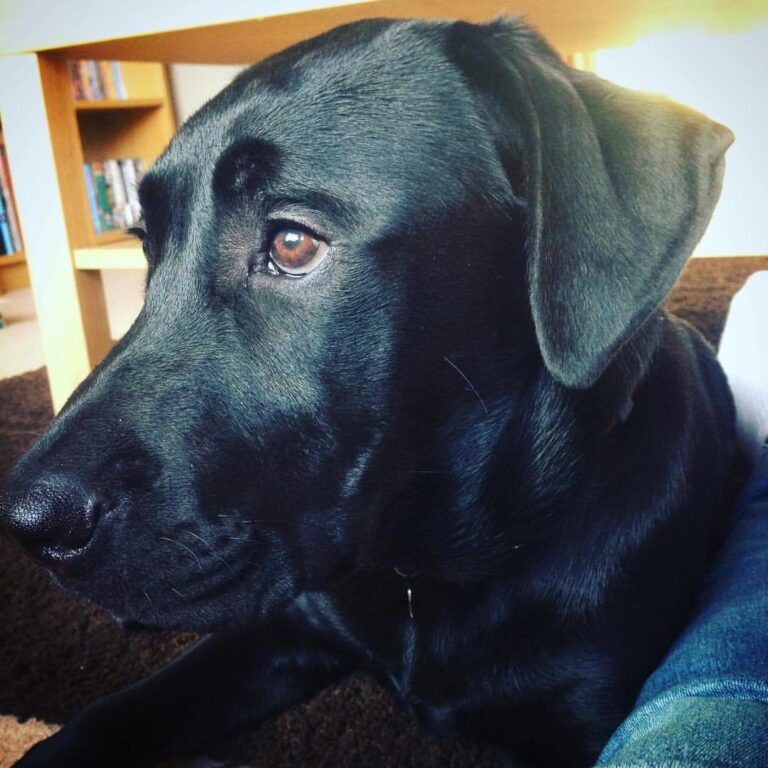We’ve had our lovely black lab, Bowie, for just over 4 months now and wouldn’t change him for the world, but wow! Have we learned a lot along the way!
To save other potential puppy owners the fast learning curve we encountered, I’ve put together a list of our top ten must-haves when getting a puppy.
1. Identification
It’s now a legal requirement to have your pet microchipped and usually a reputable breeder will arrange this before you take them home. However, as part of the Control of Dogs Order 1992, once you take your pet into a public place, he or she must also be equipped with a collar which states the owner’s name, address and post code either within it, or engraved on an attached ID tag. It’s optional to add your telephone number, but we decided to add this information to help provide a quick safe return if he ever gets lost. It’s a controversial discussion as to whether to put your pet’s name on there due to an increase in dog theft, and we decided not to, but it’s your own personal preference as to any additional information you include.
Bowie is nearly 6 months old now and has already lost two tags, so look online for cheaper alternatives to pet shop prices as it’s inevitable that you’ll need more than one!
2. Food
In my experience, bringing a puppy home almost always results in an upset tummy. It’s a stressful time, adjusting to a whole new life in brand new surroundings with strange sounds and no siblings, so don’t change too much at once. Finding out what the breeder was feeding them and buying a small supply before you bring them home is a good idea for the first week or two until their tummy settles down. After that it’s fine to gradually move them onto a quality food of your choice.
3. Food and water bowls
We made the mistake of buying Bowie a massive bowl when he was just a small pup, and quickly realised we needed a smaller one! If your puppy is tiny, there’s no point picking a huge bowl with the hope it will grow into it (dependent on the breed, it’s very likely your pup will try to use it as a swimming pool instead). Don’t make our mistake, simply buy your pet a suitable, small bowl to begin with and upgrade as they grow. Besides, who doesn’t love an excuse to shop for new pet supplies?!
4. Collar and lead
In my experience, it’s really important that you get a new pup used to a collar and lead as soon as you can. Though your little one won’t be going out straight away, putting a lead on for a few minutes per day round the house or in the garden will help to make it the norm when you’re ready to go outside and make your life much easier.
5. A crate
From my research into crate training, it seems most pups feel much more secure in an enclosed space to call their own, provided they’re only left for a suitable amount of time. Make sure your crate is large enough for your pup to have a bedding area and a separate toilet area. A dog can become very distressed if it soils its bed, not to mention the extended clean up required in the middle of the night. Bowie suffers from separation anxiety and a crate didn’t work for him, so if you’re struggling with getting your pup to settle in a crate, be sure to contact a qualified behaviourist for help and advice as though crate training is great for most dogs, it’s not a one-size-fits-all approach.
We’ve found that it is good to have a ‘time-out’ area though. If your pup becomes over-excited, it’s good to be able to use a crate or a pen to contain them until they calm down. This will not only save your ornaments but if your puppy is anything like ours, it will avoid your guests getting a sprinkler greeting!
It’s a fine line between a ‘time-out’ area and a punishment area though. It’s important to let your pup out of a time-out as soon as they calm down so it’s not seen as a negative place to be, especially if it’s an area where they are left when you leave the house.
6. Toys!
As anyone who has or has had a puppy knows, for the next few months, your house will likely look like an exploded dog creche. Bowie has a bucket full of toys and it’s important that your pup lots of different and interesting toys to play with. As well as quality chew toys for teething, products such as puppy Kongs provide great mental stimulation and also give you that glorious five minutes of peace. We bought Bowie a big Kong ‘wobbler’ to put treats in and it’s the best £10 we ever spent!
7. Training treats
Training starts NOW! Not when your pup is six months old. We started training with Bowie straight away and by the time he was 10 weeks old he was sitting, laying down, giving a paw and rolling over! The sooner you begin light training with your puppy, the easier and more natural it will be for them. Bowie loves learning, especially if we have training treats at the ready! We also tend to use his food for training too, ensuring we measure it all out to make sure he’s not being overfed.
Most dogs love to please their owners, especially sociable breeds like labradors, so as long as they receive lots of praise (and a treat!) when they get it right, you’ll be on the right track.
8. Grooming supplies
Grooming will be more important for some dogs than others. For our dog, brushing is simply a de-shedding exercise, but longer haired breeds like the cockapoo are a much more grooming intensive and require daily brushing to keep them looking fluffy and adorable! Do plenty of research into the right kind of grooming materials for your breed to ensure it is a comfortable and calming experience rather than a painful and frightening one.
Puppy shampoo and a dog towel are also a must in our house and despite bathing Bowie from a young age (and him being a water dog with a double coat) he absolutely hates it now! Using a respectable brand of puppy shampoo to get the job done as fast and as effectively as possible is key to keeping your pup clean, happy and smelling less like the cow poo they’ve previously rolled in.
We’ve also invested in puppy freshener spray in between baths to keep away any nasty smells and this was great until Bowie stole the bottle and chewed the lid off.
Once he’s stopped teething, we’ll be getting a toothbrush and some doggy toothpaste for our pup. We were advised to avoid brushing before his adult teeth come through as his gums will still be quite sore. It’s also good practice to start with some toothpaste on your finger and build up to a full toothbrush once your dog is comfortable. Many insurance policies don’t include dental treatment, so treat those doggy nashers as you would your own!
9. Carpet shampoo / pet disinfectant and LOTS OF KITCHEN ROLL.
As well as buying treats and toys for the pup, there are practical things to think about too. There will be many accidents, so be prepared. Some of the pet disinfectants on the market also remove the smell that many household cleaners don’t (not to mention that cleaners such as bleach aren’t pet friendly) so make sure you have plenty on hand for the first few months of pee-patched carpet and soiled laminate!
TOP TIP: A little bit of kitchen roll goes a long way! Buy the good quality, thick kind and you’ll be so glad you did.
10. Bitter chew spray
Now this is something I wish I had known about BEFORE my lovely lab ruined my conservatory chairs. Admittedly, it doesn’t work for everyone, but it’s worth a try if you value your furniture!
Naturally, I could go on for pages and pages on some of the great puppy must-haves, and there are plenty more, however these are our top ten that I for one couldn’t live without!
Here's our baby boy now at almost 6 months!

Lets talk
Tell us how we can help you and your pets.
Our qualifications and memberships




